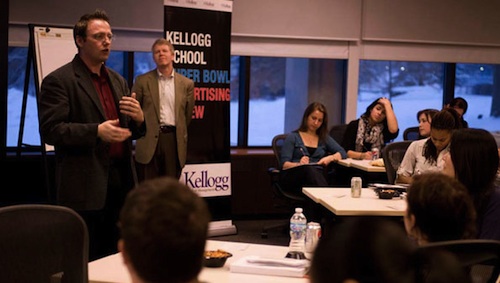That M&Ms “Anything for Love” ad was one of the big winners of last year’s Super Bowl — along with, you know, the Baltimore Ravens — when a bunch of Northwestern MBA students get together and evaluate the ads on an A-F scale. They’ve been doing this since 2005, via marketing professor Tim Calkins. Here’s the basic breakdown of the idea:
“The Super Bowl event is unique because our focus is on the effectiveness of all this advertising,” says Calkins. “So we’re less concerned about creativity and humor on its own…. Our focus is always on efficacy and trying to think, ‘is this ultimately going to have a positive impact on business?'”
And here’s how it works:
Once the game begins, the panel works nose-to-the-grindstone. Sure, students gorge on pizza and soda, but this is no ordinary Super Bowl party. Here, the commercials take center stage, while the game itself is the time for panelists to take bathroom breaks. As the spots rush by one-after-another, students score each ad with A through F grades using the ADPLAN framework. During the Super Bowl, panelists don’t discuss the grades they assign or make comparisons. Each ad stands on its own merits against how it performs against the framework.
After reviewing all the ads during the evening, the students hand in their report cards. Calkins discards the top 5% and bottom 5% of scores, taking the remaining grades and averaging them out. Calkins adds that brands like Budweiser (BUD), which runs multiple spots, are scored as a whole, not according to individual advertisements.
Roughly 30 minutes after grades are turned in, the ad rankings are revealed and the winning and losing ads are re-played. In the ensuing discussion, Kellogg students debate the fundamental strengths and flaws of various ads, always pointing back to specific ADPLAN elements for why they succeeded or failed.
The ADPLAN framework is an acronym: Attention, Distinction, Positioning, Linkage, Amplification, and Net Equity. Basically, a bunch of buzzwords you’d fully expect MBA students to toss around. Net equity, which is probably the one that’s hardest to understand on face, is about connecting the ad to the brand’s past history (lineage). Ultimately, that aspect of ADPLAN is about strengthening/reinforcing the brand.
Considering that most of these ads are about 30 seconds, this is a chaotic little scene during the breaks.
Here’s why the M&M spot embedded above was considered a big winner last year via the ADPLAN framework:
“Why did they do so well,” asks Rucker. “Branding is there through the whole spot. The characters are central. It’s playful. It fits brand equity. And it delivers a clear, distinct message.”
Got it.
Here’s some video from the 2012 Super Bowl Advertising Review:
And here’s some from last year:
I’ve taken a bunch of MBA classes by now and while sometimes they can be groan-inducing — I once had a kid answer a question by literally rattling off six acronyms in a row (“B2B, B2C…”) — this is a pretty cool exercise in general, because it takes the idea of marketing and advertising off a PowerPoint and puts it into legitimate, multi-million dollar context (which business school should do more, to better prepare its students for what they ultimately walk into). Side note that deserves its own post: in many cases, as business has become more complex and more multi-national, business school has stayed the same (I took a class this fall where the guy’s slides had a copyright of 1991 on ’em. In 1991, there was no Google. I feel like business has changed since 1991, just because of that.) This is interesting stuff, though — although I feel bad for any hardcore sports fans they pick for the panel, because you basically need to use the actual game for bathroom breaks (although honestly, by the fourth quarter there aren’t many amazing ads anyway).
I bet you these Kellogg kids are excited for the Full House reunion, though:
